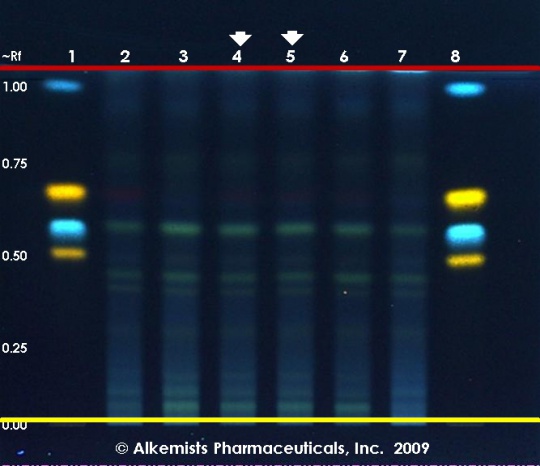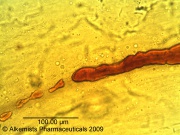Revision as of 00:01, 2 December 2012 by
JKim (Talk)
Introduction
Macroscopic Entries
Microscopic Entries
| Fragment of the corolla showing brown laticiferous vessels observed at 400x with Acidified Chloral Hydrate Glycerol Solution.cellular structures identified in this botanical specimen are fragment of the corolla showing brown laticiferous vessels and three pored pollen grain shown exuding contents when observed at 400x with Acidified Chloral Hydrate Glycerol Solution.
Source: Elan M. Sudberg, Alkemist Laboratories [1]
|
|
|
|
HPTLC Entries

Carthamus tinctorius HPTLC ID - Natural Product Reagent + PEG UV 365 nm
Safflower (flower) (Carthamus tinctorius)
Lane Assignments Lanes, from left to right (Track, Volume, Sample):
- 1 μL Rutin, Caffeic Acid, Hyperoside, Chlorogenic Acid ~ 0.1% in Methanol
- 3 μL Carthamus tinctorius-1 (flower)
- 3 μL Carthamus tinctorius-2 (flower)
- 3 μL Carthamus tinctorius-3 (flower)
- 3 μL Carthamus tinctorius-3 (flower)
- 3 μL Carthamus tinctorius-4 (flower)
- 3 μL Carthamus tinctorius-5 (flower)
- 1 μL Rutin, Caffeic Acid, Hyperoside, Chlorogenic Acid ~ 0.1% in Methanol
Reference materials used here have been authenticated by macroscopic, microscopic &/or TLC studies according to the reference source cited below held at Alkemists Laboratories, Costa Mesa, CA.
Stationary Phase Silica gel 60, F254, 10 x 10 cm HPTLC plates
Mobile Phase ethyl acetate: AcCOOH: HCOOH: H2O [10/1.1/1.1/2.4]
Sample Preparation Method 0.3 g + 3 ml CH3OH sonicated + heated @ 50° C ~ 1 hr
Detection Method Natural Product Reagent + PEG -> UV 365 nm
Reference see Adapted from Plant Drug Analysis, Wagner, H., 1996
Source: Elan M. Sudberg, Alkemist Laboratories [2]
|
Other Points of Interest
Cite error: <ref> tags exist, but no <references/> tag was found


